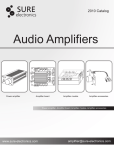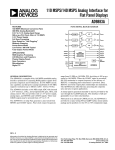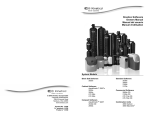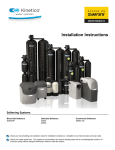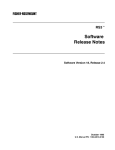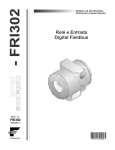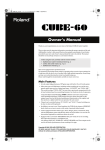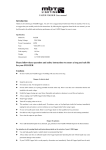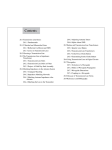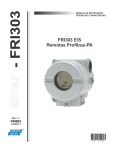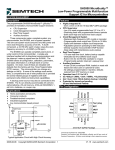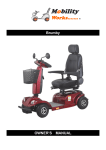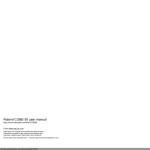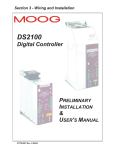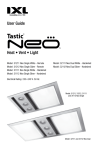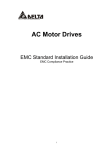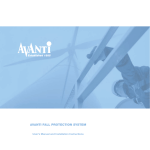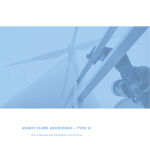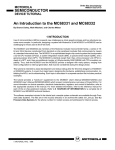Download AN-04: EMI Considerations Designing DDX Amplifiers
Transcript
EMI Considerations Designing DDX Amplifiers For Applications Assistance Contact: Mike Danielson Apogee Technology, Inc. 129 Morgan Drive Norwood, MA 02062, USA [email protected] Apogee Technology, Inc. Document #07010001-01-00 Table Of Contents Abstract........................................................................................................2 Introduction ..................................................................................................3 Background ..................................................................................................3 EMI Regulations and Measurements........................................................3 Conducted Emissions and Limits.............................................................3 Radiated Emissions and Limits................................................................5 Sources of Emissions (Noise), and General Suppression Methods ..................6 Differential Mode Noise..........................................................................7 Common Mode Noise .............................................................................9 Finding the Noise Sources .....................................................................11 Conclusion .................................................................................................12 Appendices...................................................................................................1 Appendix A ............................................................................................1 Modifications to EB-2060S to be Class B compliant...........................1 Appendix B.............................................................................................3 Verification Test Report ....................................................................3 Appendix C...........................................................................................10 Checklist of Do’s and Don’ts ...........................................................10 Appendix D ..........................................................................................11 Schematic Examples of Suppression Components ............................11 References.....................................................................................................i Apogee Technology, Inc. 1 Document #07010001-01-00 Abstract Contrary to popular belief, meeting EMI regulations with digital PWM switching amplifiers is not black art. Switch mode power supplies have been doing it for years. What is required is an understanding of the sources of noise and the hidden circuit paths that allow it to escape to the environment. In most cases it is not the actual PWM output that is the culprit but rather things that are already familiar to engineers designing consumer digital audio equipment; power supply currents and the clock signals used in all digital circuits. This application note discusses signals that create emissions from a DDX amplifier circuit and effective methods of identifying and suppressing these emissions. Using the guidelines presented in this application note an EB-2060S evaluation board was modified and demonstrated to pass Class B emissions requirements. Apogee Technology, Inc. 2 Document #07010001-01-00 Introduction When designing products utilizing digital signal processing or digital signals in general, audio or otherwise, attention must be paid to meeting Electromagnetic Interference, (EMI), regulatory requirements for different types of equipment. The importance of meeting these standards is obvious, in countries where EMI regulations are in force, using or selling a non-compliant product is not permitted. In this application note major regulatory requirements are reviewed, as are the types of noise that cause problems. Methods of identifying and suppressing emissions will be discussed and a modified DDX evaluation board is shown to pass Class B requirements without needing to be enclosed in a chassis. Background EMI Regulations and Measurements DDX amplifiers, are for the purpose of EMI regulations, considered Information Technology Equipment, ITE, as they receive, process and use digital data. The major standards are FCC Part 15, subpart B, in the US, EN55022 in Europe, and VCCI in Japan. At the time this application note was written, meeting the most stringent requirements of these standards covered the requirements of most countries, however, the manufacturer is responsible to meet the requirements of any country that your product will be sold or used in at the time your product is manufactured. Always check for the most current standards as regulations are subject to change. This application note does not cover the methods or requirements of setting up a test facility to guarantee measurements can be made to the accuracy required for product approval, but is intended to show methods of discovering the areas that cause emissions and address typical solutions when developing products with DDX technology. For product approval, measurement of the emissions should be made at a facility that is certified to be in compliance with the criteria established by the relevant regulations and agencies. Certification is generally an indication of traceable calibration and measurement repeatability to recognized standards. Repeatability of measurements is key to demonstrating a product meets standards. What exactly is measured? Two types of emissions are of concern; Conducted Emissions is the radio frequency energy that a product transmits along its power cord to the AC Mains, (also DC Mains in some countries), and Radiated Emissions is the radio frequency energy transmitted by the product into the air. Conducted Emissions and Limits Conducted emissions are measured as a voltage, expressed in dBµV, using a line impedance stabilization network, LISN, and a measurement receiver, typically a spectrum analyzer, connected to the LISN’s output port. A typical LISN schematic is shown in Figure 1. Its function is to supply a stable 50 ohm load impedance for the noise signals on the equipment under test, (EUT), power cord. A commercially available LISN and an AC line conditioner are recommended for development work. Apogee Technology, Inc. 3 Document #07010001-01-00 L1 AC Power In EUT AC Power Cord Phase EUT C1 R1 Ground To Receiver R2 C2 L2 Neutral AC Power In AC LISN Figure 1 Conducted emission limits for the US and Europe are given in the tables below. Table 1, EN55022 Class B Conducted Emissions Limit Frequency Quasi-Peak Limit Average Limit 0.15 to 0.5 MHz 66 dBµV to 56 dBµV 56 dBµV to 46 dBµV 0.5 to 5 MHz 56 dBµV 46 dBµV 5 to 30 MHz 60 dBµV 50 dBµV Note that the stricter limit applies at the frequency transition points. Table 2, FCC Class B Conducted Emission Limit Frequency Quasi-Peak Limit 0.45 to 30 MHz 48 dBµV A comparison shows that the FCC limits for conducted emissions are stricter than EN55022 limits between 450KHz and 30MHz but that EN55022 extends down to 150KHz where the FCC has no specification. When designing for conducted emission the goal should be to meet both resulting in the following. Table 3, Design Specification for Conducted Emissions Limit Frequency Quasi-Peak Limit Average Limit 0.15 to 0.45 MHz 66 dBµV to 48 dBµV 56 dBµV to 38 dBµV 0.45 to 30MHz 48 dBµV Apogee Technology, Inc. 38 dBµV 4 Document #07010001-01-00 Average measurement is the typical mean value of a waveform whereas quasi-peak better represents the envelope of a waveform and detects short duration higher energy signals better than the average measurement. The spectrum analyzer chosen for development work ideally should be capable of both but in most cases an average responding instrument will be sufficient. Bandwidth up to 1GHz is desirable, as it will cover the radiated emissions range for DDX amplifiers as well. A third item, an inductive current clamp is required for development work. It is useful for identifying the frequencies of currents being conducted by wires inside or outside the product and determining in a relative manner the effectiveness of the applied suppression techniques. This can be of either the passive or active variety but should be for 50 ohm termination to be consistent with input impedance of most spectrum analyzers. Radiated Emissions and Limits Radiated emissions are measured as electric field strength, expressed as dBµV/m, by an antenna at a test distance of 10 meters from the EUT. A 3 meter distance is sometimes used to distinguish the emitted signal if a background signal is very strong, note that 3 meter testing is not accepted by all standards. This measurement is done with the EUT mounted on a non-conductive table at a height of 0.8 meter, the antenna is mounted such that it can be raised or lowered from 1 to 4 meters and rotated so that it can be set to measure the maximum signal emitted from the EUT. Both the EUT and receiving antenna are mounted over the same ground plane of metal sheeting or screening to permit additional EUT signals to be reflected to the antenna. The antenna and receiving system must be calibrated and correction factors applied to the raw measurement data to compensate for signal loss in the antenna and interconnect cable. At a test facility this test can typically run six hours or more as both the EUT and antenna must be rotated and moved in height to ensure that the maximum signal is being received in each scanned frequency range. Table 4, Radiated emission limits for the US and Europe Frequency FCC Class B EN55022 Class B Quasi-Peak Quasi-Peak (dBµV/m) (dBµV/m) (MHz) 3meter 10meter 3meter 10meter 30 to 88 40 30 40 30 88 to 216 44 33 40 30 216 to 230 46 36 40 30 230 to 960 46 36 47 37 960 to 1000 54 44 47 37 Note that as DDX amplifiers use less than a 108MHz clock, the maximum frequency subject to examination is 1GHz. Apogee Technology, Inc. 5 Document #07010001-01-00 Again as for the conducted emissions a design specification for the strictest requirements can be generated. Table 5, Design Specification for DDX amplifier radiated emissions Frequency Class B Quasi-Peak (dBµV/m) (MHz) 3meters 10meters 30 to 88 40 30 88 to 216 40 30 216 to 230 40 30 230 to 960 46 36 960 to 1000 47 37 As with the conducted emissions the stricter limit applies at a transition frequency. Note also that a 2 dBµV/m margin should be allowed to account for measurement repeatability. Clearly it is much more difficult to replicate the radiated emissions test set up, primarily due to space constraints and the need to be away from interfering background signals. For development purposes both the inductive current clamp, mentioned for conducted emissions, and a near field probe kit are used to determine the frequencies that are emitted and again in a relative manner the effectiveness of the suppression technique. Near field probe kits are available commercially and are offered as both active and passive devices, again 50 ohm termination will be required to match the spectrum analyzer input impedance. Near field probes are usually constructed to detect either magnetic fields or electric fields while rejecting the other. Magnetic probes are essentially loop antennas made from a single turn of semi-rigid coax cable and electric field probes are made from a stub of semirigid coax cable. It is possible to construct near field probes but the commercial variety typically are more durable and come with sensitivity curves similar to antenna correction factors. These probes are connected to the spectrum analyzer and brought into close proximity to the circuit in order to determine both the frequency content and type of emission being radiated. Sources of Emissions (Noise), and General Suppression Methods As previously discussed there are two types of emissions that are of concern, conducted and radiated. What is most important in suppressing these emissions is to understand how they are generated and to identify the source. Suppression of EMI is most effective when applied at the source. A good board layout is the first step to minimizing emissions. Noise can be classified into two types according to the mode of conduction, Differential Mode Noise and Common Mode Noise. Apogee Technology, Inc. 6 Document #07010001-01-00 Differential Mode Noise Differential mode noise is conducted on a pair of signal lines or on a power line and ground in opposite directions to each other. This is represented as normal current flow in a system and is shown in Figure 2 below. Signal Source LOAD Noise Source N Figure 2 Differential mode noise The Noise Source represents the high frequency current generated by the switching of digital circuits, i.e. the emission generator; and the Signal Source can represent either a power source or information signal source, i.e. the desired signal. The load can represent a digital IC load or other active device on a power supply or a circuit load, like a loudspeaker, depending on the function of the Signal Source. Differential noise can be considered a 'conducted emission' in that the unwanted signal is conducted between the Signal Source and the Load or between the Load and Signal Source depending on which is generating the noise. It only becomes a conducted emission from a regulatory sense when the Signal Source is the AC Mains and the Load is the EUT with the Load generating the noise. However, it is possible for this 'conducted emission', generated by a products internal circuitry, to become a 'real', in the regulatory sense, radiated emission. Remember that any changing current generates a magnetic field, H field, around the wire carrying it, this H field can radiate directly or induce currents in nearby circuits that will carry the noise to other places in the product. Laying out circuit boards such that the physical conductors carrying the noise current in opposite directions are close together can minimize this. Each conductor will generate an equal but opposite H field resulting in a net H field of zero. This especially applies to the power bus structure supplying the circuit’s active devices and to the switching output of the amplifier power stage where the 'noise' currents are actually required for proper operation of the circuit. These traces should be kept as short as practical and their high frequency impedance minimized as any differential voltage will also generate an electric field, E field, between points in the circuit. Again the E field can either radiate directly or couple to other circuits. Design Considerations Consider the case of the power supply to the amplifier power output stage. The power output stage draws large peak current during the switch transitions resulting in a very high change in current during a very short time. This current, if allowed to circulate as shown in Figure 2, will result in a large radiated signal from both E and H fields; fortunately good layout and circuit bypassing are effective at reducing the emissions from this necessary Apogee Technology, Inc. 7 Document #07010001-01-00 current flow. High frequency bypass capacitors, such as ceramic or tantalum dielectric, should be placed as close to the power device as practical, this will constrain the majority of high frequency current flow to the immediate area of the bypass capacitors and the power output stage as shown in Figure 3, note that these are in addition to the large bypass capacitors required for the lower audio frequencies. Signal Source (Power Supply) LOAD (Power IC) Noise Source N Figure 3 Load Bypassing Power supply lines should be laid out so that supply and return lines run together as previously mentioned. These two items, properly applied to all active devices, will significantly reduce the area this noise signal travels around and subsequently the associated emissions. A ground plane is strongly recommended for DDX amplifier applications for both EMI and Thermal considerations. When using a ground plane in high frequency applications care must be taken to understand the impedance and current flow in the actual circuit path. As an example, Figure 4 shows a ground plane with two signal trace routings. Trace A is the most direct path to the load from the perspective of the source but passes over a void in the ground plane. This forces the return current to flow around the void to follow the path of least resistance back to the source. At DC this would not be an issue, however at high frequencies a radiating loop antenna is formed and circuit inductance is increased. Trace B offers the lowest impedance at high frequency as the conductors run together minimizing circuit inductance. It also produces the desired field cancellation. Ground Plane Void Trace A Trace B Source Load Ground Plane Figure 4 Apogee Technology, Inc. 8 Document #07010001-01-00 All digital signals contain high frequency components due to their fast rise and fall times. As good practice do not allow digital signals or power traces to digital devices to cross a void in a ground plane. Sometimes it is not possible to avoid this or it gets overlooked during layout. In those cases it may be necessary to increase the circuit impedance at the noise frequency to significantly reduce the noise current. Figure 5 shows a representation of this. The inductor can be a real physical inductor or can represent a ferrite bead. Ferrite beads increase circuit impedance by dissipating energy as heat and so act primarily as resistive components in the circuit. They are generally only effective under low bias current conditions for differential mode noise as their impedance can be significantly reduced with increasing bias current. Typically the use of ferrite beads is limited to signal levels for reducing differential mode noise and physical inductors or ‘chokes’ are applied to power bus signals. The capacitor shown in Figure 5 is generally a real physical component for power circuits and is a stray capacitance when ferrite beads are applied. In either case the principle of reducing the loop radiating area applies. Signal Source LOAD Noise Source N Figure 5 Differential noise suppression Common Mode Noise Common mode noise is conducted generally on a pair or group of signal lines or on power lines in the same direction. This is represented in Figure 6. Signal Source LOAD Noise Source N Cstray Cstray Reference ground surface Figure 6 Common mode noise Apogee Technology, Inc. 9 Document #07010001-01-00 As shown in Figure 6, common mode noise is similar to differential mode noise in that current flows in a loop. This loop is again the emissions radiator. What is different is that the return conductor, the reference ground surface, is not always as easy to clearly identify. For most electronic products the metal chassis becomes one, fortunately it is also a very good shield for most internally generated emissions. An example of this would be a digital clock line that goes to an expansion header but is unconnected to other circuitry. The return path for this clock signal is now through stray capacitance to the chassis back to its source. Signals such as these can radiate internally and appear at multiple places in the product, thus the importance of controlling EMI at its source, one suppressor is better than many. Design Considerations More common mode emission problems tend to appear at the interfaces of products where cabling enters or leaves the chassis. Generally coupling is due to pickup of internal emissions or from board conductors to signal paths that lead outside the chassis. These signals can have the earth itself, coupled through stray capacitance, as the return path. A good example to avoid in DDX amplifiers is power supply traces to the DDX power output devices should not run under, or be made into a plane layer under the audio output filter components. This will cause noise to be coupled to inductors or traces that then connect to the outside world after the PWM signal filter resulting in a radiated emission from common mode noise on the speaker lines. Fortunately common mode filtering is effective and easy to apply. Figure 7 shows the use of a common mode ‘choke’, essentially a ferrite core transformer wound to induce opposing currents in the opposite winding to cancel the common mode currents. Ferrite beads are also extremely effective in this application, as the net field due to the differential signal current flow is zero they do not suffer from impedance decrease due to a bias current as a bead around a single wire would. This allows ferrite clamps to be used on multiconductor cables as well. The transformer principle applies to beads as a few turns can be made on a bead core to increase its loss impedance. Generally frequency determines the choice of a common mode bead or common mode choke as the inter-winding capacitance of multiple turns limits the loss at higher frequencies and they are sometimes both used to fully cover a broad frequency emission range. Signal Source LOAD Noise Source N Common mode Choke or Bead Cstray Cstray Reference ground surface Figure 7 Common mode suppression with ferrites Apogee Technology, Inc. 10 Document #07010001-01-00 Another effective method of suppressing common mode noise, particularly where cables enter or exit a product is to use capacitors to couple the common mode noise to the product chassis. This is represented in Figure 8. The noise is then able to couple back to the source and remain inside the chassis. A separate interface ground is typically used on a PCB to allow a single point connection to chassis or circuit ground of multiple bypass capacitors at an I/O interface area. It is also possible to combine choke and capacitor techniques for EMI filtering. Signal Source LOAD Noise Source N Cstray Cbypass Cbypass Metallic chassis Reference ground surface Figure 8 Common mode suppression with capacitors Finding the Noise Sources The time to look for noise sources is at the start of a design. Identify those signals that can potentially cause problems with conducted or radiated emissions. For a typical DDX amplifier these signals will be power supply distribution, clocks, the PWM output and drive circuits and to a lesser extent general logic signals. Pay close attention to the power supply bypassing and the PCB and chassis layout keeping in mind how differential and common mode noise becomes a radiated or conducted emission. Missing this step can result in the need for excessive suppression components and methods or in the worst case having to respin the design. The method of finding the residual noise sources is straightforward, after examining the design and layout there should be some expectation of what to look for and where. The product must be configured as the final consumer will use it, that is as generally hooked up and operating in a typical fashion. Before going for verification test a pre-scan should be performed to identify emissions and steps taken to determine where and how to suppress them most effectively. Some of the steps can be implemented directly or planned to be implemented at the test site if required, which to do becomes a matter of experience. In any event you should arrive at the test site with a plan based on information from the pre-scan. The scan needs to be performed with sufficient resolution to determine a signal from a group of signals, for a DDX amplifier a detection bandwidth of 120 KHz is generally adequate for radiated pre-scans. When doing a pre-scan outside of a screen room the background level being picked up for each measurement should be determined with the EUT switched off. Apogee Technology, Inc. 11 Document #07010001-01-00 Using the spectrum analyzer and the inductive current clamp determine the signal components that are being conducted out of the EUT on its cables both for common mode and differential signals, record frequency and amplitude for each significant signal. Use the current clamp to determine the common mode signal on the AC power cord and the LISN to determine what is conducted on each wire. Suppression of line-conducted emissions will likely use a line choke in combination with a capacitive bypass to chassis filtering due to the lower frequencies; provisions for this should be made at the design stage. Use knowledge of the system design to determine if the frequencies are fundamentals of the system or harmonics. Do not be surprised to see very high order harmonics; the small geometries on PCB’s do not make efficient antennas at low frequencies. Next take the most sensitive near field loop probe, H field, and bring it near enough to the EUT to start seeing a signal, as an emission can be radiated in any direction the probe should scan a spherical radius about the EUT. Identify these far field signals first as they are more likely to cause compliance issues. The ones closer to the EUT are likely related and will be suppressed along with them. Find the strongest signal and note the distance and direction from the EUT as well as the frequency and amplitude. Switch to progressively less sensitive probes and follow the line of maximum emission to identify where it is coming from on the EUT. Trace the emission to its source inside the unit using the smallest loop or small E field probe and determine which method of suppression can be applied. Apply the suppression and repeat the measurement to determine its relative effectiveness. If no change is apparent then the source was not properly identified. If the emission is eliminated or significantly reduced then it was the only or main source. In addition to the frequency information from the spectrum analyzer, a time domain waveform of the radiated signal should be viewed either by demodulating the signal with the analyzer or by hooking the probe to an oscilloscope to gain more insight into the offending waveform. More extensive information on determining the sources and types of emissions can generally be found in the near field probe manufacturers users manual. Conclusion In summary, during the product design phase minimize the problems you know about. Prescan in the lab to understand what remains and determine methods to suppress it. Go to the verification test site prepared to implement several techniques as schedule and budget requirements generally have a role in determining the ‘best’ solution. Remember that the test conditions of pre-scan and verification are usually not the same, frequencies that had not been identified as problems can appear, and vice versa. Be ready to identify and suppress new emission sources at the verification site. If the attempt to reduce an emission fails it is due to one of four reasons, 1. The diagnosis of the source is wrong. 2. The suppression technique is not correct for the identified source. 3. The suppression technique is not properly applied. 4. A second source at the same frequency or other outside factor is involved. Apogee Technology, Inc. 12 Document #07010001-01-00 Do not leave the verification site without gathering as much information as possible about a failure; it will be invaluable back in the lab. Regulatory requirements have been reviewed and methods of identifying and suppressing emissions relevant to DDX amplifiers have been offered that will be effective in meeting those requirements. A specific example of configuring a DDX amplifier is given in Appendix A. Using the techniques and methods presented in this application note the Apogee EB-2060S stereo evaluation board, a Class A laboratory device, was modified to meet Class B limits for a typical application without benefit of a shielding chassis. Appendix B shows scanned images of the Certificate of Compliance, report highlights and photographs of the EUT. Appendix C is a checklist of do’s and don’ts for quick reference when designing your system. Appendix D shows schematic circuit examples of typical suppression components applied at PCB interfaces. Additional information on EMI suppression is available from the ferrite and suppression component manufacturers listed in the References section. Apogee Technology, Inc. 13 Document #07010001-01-00 Appendices Appendix A Modifications to EB-2060S to be Class B compliant The EB-2060S evaluation board was tested on 5/17/01 as an unenclosed board and passed radiated emissions at 10 meters. A simple open frame linear power supply was constructed and used and the 5-volt switching regulator supplied on the stock EB-2060S evaluation boards was replaced with a linear regulator. This was to insure that switch mode regulator and power supply emissions did not obscure EMI issues related to DDX amplifier components. The optical input was used also to not obscure EMI issues. The input signal was -14 dBFS pink noise with +12 dB of gain applied to replicate a typical full power music output at approx. 9Wrms/Ch. No modifications were made during the radiated test, but pre verification testing the board was modified based on the pre-scan activity as follows: Filtering components added to inputs or outputs; Speaker leads; -- Modified to include common-mode beads, Steward P/N CM3322X630R-00, between the filter output and speaker, (8 ohm loads). These were mounted on the PCB and filter a common mode current from the speaker leads. Power leads from EB-2060S to open frame linear supply, -- A Fair-Rite 2673002402 shield bead with 6 turns of #24 wire, wound common mode, on the power input wires, this was to address low frequency common mode conducted emissions that radiated off the DC power lines to the power supply, it is unlikely this bead would be required if the power supply and amplifier share the same PCB. A FairRite 2643002402 shield bead with 3 turns of #24 wire, wound common mode, was installed between the 2200uf bypass capacitor and the power input connector, for the high frequency emissions. Note that these beads appear in series and each covers a different frequency band. Using type 31 material from Fair-rite would accomplish the function of both with a single bead but was not available at the time. Also note that the Steward P/N CM3322X630R-00 is effectively the same as a Fair-Rite 2643002402 shield bead with 3 turns of #24 wire but is easier to use, as it is a surface mount component. More information on these beads and ferrite material characteristics can be found at the respective manufacturers websites, www.steward.com and www.fair-rite.com. On the evaluation board connectors J6 and J7 are expansion headers to allow use of other IIS sources for development purposes, in a real application they would not be present. All traces from these headers were cut at the signal source on the PCB and grounded to prevent them from acting as antennas for the 256*fs clock recovered from the S/PDIF receiver. Apogee Technology, Inc. 1 Document #07010001-01-00 A ferrite bead, Fair-rite 2508051217Z0, was added to the 256*fs MCLK output of the S/PDIF receiver to damp a differential mode emission that coupled common mode to the power supply and speaker leads. The emission is due to the MCLK line crossing several ground plane voids. During the conducted test a 0.1uf capacitor was added across the rectifier bridge/transformer windings to tame the diode commutation spikes. This is a typical linear power supply that one would use in a stereo powered speaker application. The transformer winding was rated at 53VA and supplied 28VDC to the evaluation board during operation. Full bridge rectification was used and filtered at the power supply with a 4700uf cap. The transformer core and mounting were connected to earth ground by the third prong of the power cord. The circuit ground was connected to the earth ground by a 2200pf coupling capacitor. During the pre-scan the conducted emissions were found to be due to primarily common mode conduction of the output PWM frequency and required the installation of a common mode choke. The power line filter use was a Murata PLY10A2821R2R03B1 combination differential/common mode line choke. Specifications are available at www.murata.com. Apogee Technology, Inc. 2 Document #07010001-01-00 Appendix B Verification Test Report Excerpts from the EB-2060S evaluation board verification test report by permission of Integrity Design and Test Services, Inc. Apogee Technology, Inc. 3 Document #07010001-01-00 Apogee Technology, Inc. 4 Document #07010001-01-00 Apogee Technology, Inc. 5 Document #07010001-01-00 Apogee Technology, Inc. 6 Document #07010001-01-00 Apogee Technology, Inc. 7 Document #07010001-01-00 Apogee Technology, Inc. 8 Document #07010001-01-00 Apogee Technology, Inc. 9 Document #07010001-01-00 Appendix C Checklist of Do’s and Don’ts Before beginning the design - Understand the requirements of the countries your product will be sold in. - Be familiar with the operation of DDX amplifiers and the spectrum they generate, the PWM frequency and harmonics dominate conducted emissions and the master clock harmonics dominate radiated emissions. - Be familiar with other digital components in your product, particularly switch mode power supplies. - Understand the concepts of Differential and Common Mode Noise. - Understand the techniques and components used to suppress emissions. - Make sure you will have the proper equipment on hand for evaluating EMI and understand how to use it. - Plan for pre-screening your product and make allowances for a second iteration. During the design and prototyping - Treat the product as a whole, the chassis design and board layouts must compliment each other to minimize emissions. - Understand how and where current flows in your design and identify critical areas to layout first to minimize emissions. - Make allowances for suppression components in critical areas, especially at I/O interfaces, it is easier to remove or leave out a component than to add one. - Pay particular attention to power supply routing and bypassing, and to the routing of the PWM outputs and the filter layout. Current flowing out needs to return back on the same path. - Use a ground plane, unbroken as possible, and keep connections short. - Do not let digital signals cross a void in the ground plane, allow space for using a ferrite bead if you can’t avoid it. - Do not make unconnected stub traces on digital signal lines. - Be aware and check for common mode coupling, do not route noisy signals were they would couple to traces or wires leading outside the chassis. - Review the entire design before committing to hardware. A fresh set of eyes may catch something you have missed, even better if they have EMI experience. - Pre-scan your PCB and product with near field probes; know what emits and how before the verification test. At the Test Site - Look for the problems you know about, be ready with more than one method of suppressing an emission if possible. - When you fail to suppress an emission get as much information at the test site as possible. Apogee Technology, Inc. 10 Document #07010001-01-00 Appendix D Schematic Examples of Suppression Components This is an example of EMI filtering for DC Power and Speaker lines for a DDX amplifier. Generally all components will not be required in most cases, but is illustrative of typical methods of suppressing unwanted signals from conducting off a board. The combination of ferrites and capacitors produce simple RC filters. Note that different values of capacitance and types of ferrites will be required depending on the frequency to be filtered. Care must be taken to not run noisy signals under or near the input for the DC Power, or the output for the Speaker lines of these filters or noise can be coupled to wires leading off of the PCB nullifying any benefit of the filter. In some instances, such as prototyping, it is advantageous to have a separate interface ground to bypass to. This allows the ‘Interface Ground’ to be connected to either circuit ground or chassis ground in any manner, AC with a capacitor or DC with a zero ohm jumper, 0JMP. It also keeps normal circuit currents away from the I/O areas of the PCB. Power to DDX-2060 L1 DC Power in C3 4.7nF C4 4.7nF CM Ferrite C1 4.7nF C2 4.7nF Noise OJMP or Cap Interface Ground Circuit Ground L2 Speaker out From the DDX 2060 output filter 1 2 C5 10nF CM Ferrite Noise C6 10nF C7 10nF OJMP or Cap Circuit Ground Apogee Technology, Inc. Interface Ground 11 Document #07010001-01-00 Typically if the application has a chassis, and the power source is in the chassis, the DC Power input filter is not likely required. Its purpose is to prevent coupled noise from radiating off a connecting cable to the power supply. It that case, a similar filter will likely be used on the AC power line for conducted and radiated emissions. The frequency range of most common mode ferrites starts to become significant in the range of 10MHz up, below this frequency wound choke coils tend to be more effective. Apogee Technology, Inc. 12 Document #07010001-01-00 References EMC Test Systems, (1999). User’s Manual, Near-Field Probe Set, Model 7405. http://www.fair-rite.com, online product catalog, “Choosing Ferrite Materials”. http://www.murata.com, online product catalog. http://www.steward.com, Application notes, “Use of Ferrites” and “EMI Testing”. Apogee Technology, Inc. i Document #07010001-01-00



























